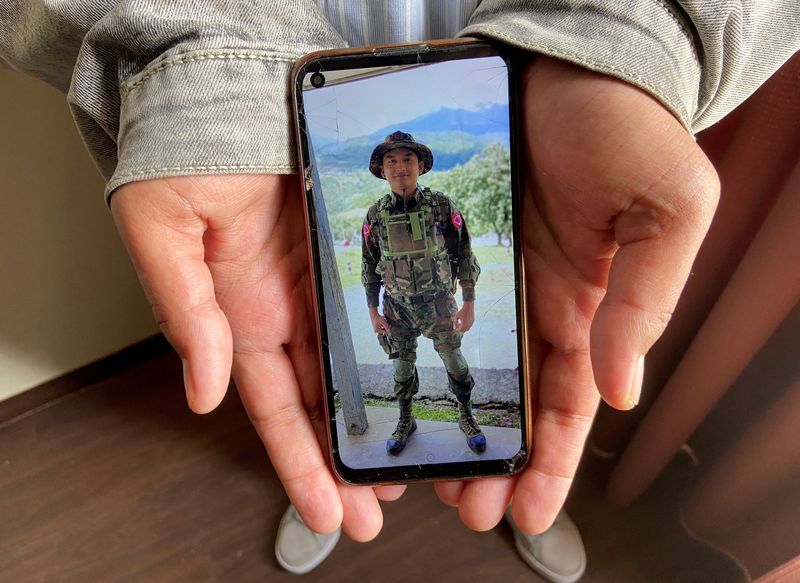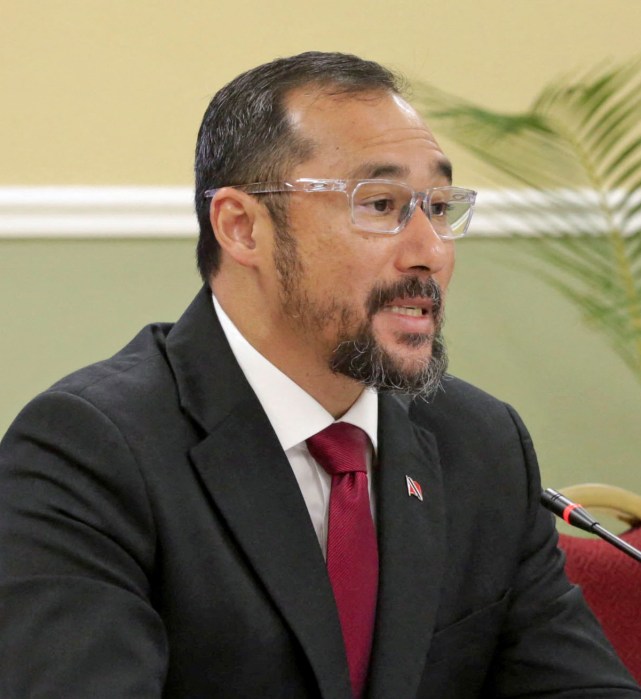(Reuters) – A Myanmar army officer who defected and fled the country has detailed battlefield losses to rebels in the southern part of Chin state, with at least 50 soldiers killed and 200 badly wounded in 2021 by opposition fighters with homemade weapons.
Kaung Thu Win, a captain who defected in December, offered a rare first-hand account of intensified fighting in Chin, in Myanmar’s northwest, where the military junta has faced some of the fiercest armed resistance since it seized power a year ago.
He said he switched sides after hearing reports by colleagues of military abuses during clashes last year.
Speaking in northeastern India where he and his family have fled, the 32-year-old showed Reuters his national and military identity cards and detailed 12 incidents between May and December in which soldiers were killed or wounded by rebels.
He also showed Reuters some 30 classified army documents he said backed up his version of recent events in southern Chin state, where civilians opposed to the coup have taken up arms and are working with an established ethnic insurgent group.
He based his estimate of military casualties on that information.
The documents, stored on his mobile device, add new details of a major clash near the town of Mindat that have not previously been reported. They provide further evidence of a growing popular rebellion against Myanmar’s military rulers that has spread across the country.
Four other Myanmar defectors who reviewed some of the documents said they mirrored others they had seen in terms of language, format and descriptions of combat.
Myanmar’s military, known as the Tatmadaw, has acknowledged battlefield losses, but it has not provided details.
The Tatmadaw did not respond to requests for comment on events in Chin, the account given by Kaung Thu Win or the documents he produced. The military has previously described armed groups opposed to the junta as “terrorists”.
The Indian home ministry did not reply to a request for comment on Myanmar defectors seeking refuge across the border with Chin.
Groups of fighters began forming in Chin state in the weeks after the Feb. 1 coup, but the Tatmadaw felt the full force of the rebellion after a convoy of seven vehicles was ambushed near the town of Mindat on May 14, according to Kaung Thu Win.
In the Mindat attack, one of the biggest clashes reported so far, hundreds of rebel fighters attacked the convoy around dawn, firing at troops from hillside positions, leaving five soldiers dead and 37 personnel unaccounted for, according to one of the documents.
“We were attacked by an estimated 1,000 insurgents,” read an internal field report on the fighting. “Six army trucks were burned down, and many weapons were lost.”
CASUALTIES MOUNT
In addition to details about the Mindat attack, the documents shown by the former captain include maps of military facilities in southern Chin state, information about army supplies and battlefield reports of skirmishes with rebels.
The fighting in the southern areas of Chin, involving hastily formed Chinland Defence Force (CDF) guerrilla groups, has been fierce.
Kaung Thu Win said at least 20 Myanmar soldiers were killed in the May 14 ambush.
“It was only after the May 14 incident that the Tatmadaw started taking the CDF seriously,” he told Reuters in an interview. “It was a meeting of … hunting guns (used by the CDF) and modern weapons.”
The military did not respond when asked whether this ambush represented a turning point.
The captain said his position as liaison officer meant that military documents, including those detailing supplies and convoys, were provided to him by staff at the regional headquarters that oversaw his frontline outpost in Chin.
He said he also had access to accounts of the Mindat ambush because he was part of the military investigation into the incident.
The ex-officer did not know the outcome of the probe, but said Major Yan Naung Htoo, who was involved in the battle, was put under house arrest in Monywa around September.
Reuters has been unable to reach the officer. The military did not comment when asked about his situation or a broader probe.
A Jan. 10 statement from a CDF group in Kalay said Kaung Thu Win had handed them guns and ammunition. The group said they had led the captain and his wife to a safe area and paid him for the arms. His wife had just given birth to their first child.
A spokesman for the Kalay defence force, CDF KKG, said they paid the captain around 6 million kyat ($3,300). That was below the estimated value of 9 million for the weapons and ammunition, but the group could not afford the full amount, the spokesman added.
He said defectors were under no obligation to the defence group, but they ask them about Tatmadaw operations before moving them to safety.
The captain confirmed he had been paid by the CDF KKG in return for the weapons, but declined to say how much.
‘ARMED INSURRECTION’
The Myanmar military continued to suffer steady casualties throughout 2021, as guerrilla outfits across the state gained strength, according to Kaung Thu Win.
His account of the May clash underlines the scale of resistance to Myanmar’s military. Some analysts now call the conflict a civil war.
The military calls the rebellion an “armed insurrection”, and military ruler Min Aung Hlaing said there were more than 9,000 “terrorist attacks” last year. The junta said in January it had “largely restored national stability” by the second half of 2021.
Soldiers whose bodies are not immediately found following a battle are often classified as unaccounted for, Kaung Thu Win said, explaining the difference in fatalities listed in the report of the Mindat ambush – five – and his estimate of 20.
A CDF statement on Jan. 26 put the death toll among troops at 1,029 across the whole of Chin between April and December 2021. During that period, CDF groups sustained 58 fatalities, alongside 27 civilian deaths, the statement added.
Opposition groups say more than 1,000 soldiers have swapped sides in recent months.
The Tatmadaw declined to comment when asked about the figures from the captain and resistance groups.
‘LOVED MY JOB’
The youngest of three children born to civil servants in Myanmar’s Yangon region, Kaung Thu Win said he entered the prestigious Defence Services Academy in 2006. Reuters could not reach the academy for comment.
Three years later, he graduated from the military university and joined Light Infantry Battalion 216, which was deployed to Myanmar’s Karen and Shan states to fight ethnic armed groups battling for greater autonomy.
During some operations in Shan, he said he saw civilian properties destroyed, but deemed such incidents the inevitable consequence of armed conflict.
“I was proud of my work and I still loved my job,” he said.
In 2016, Kaung Thu Win said he was sent to a command post in Chin state’s Matupi town. He said he was posted as its liaison officer at a regional command centre in Monywa when the military staged the coup last February.
He recalled seeing Tatmadaw helicopters flying in wounded troops from the front for treatment at Monywa base, he added.
In October, the military began sending reinforcements into southern Chin state, taking the total number of troops in the area to some 1,200, up from 800 previously, Kaung Thu Win said. CDF fighters have also said troop numbers have increased.
Around the same time, the captain also began hearing of Tatmadaw troops torching villages along the routes their convoys would take, sending civilian populations fleeing into forested areas for safety.
“I received first-hand information (from colleagues),” he said, “I decided to defect because, after the coup, I’ve seen so many stories and events where the lives and possessions of citizens were targeted intentionally by the Tatmadaw.”
Late last year, the United Nations, human rights groups and foreign governments raised concerns over the Myanmar military’s heavy-handed response to uprisings in Chin state.
Some rights groups warned it mirrored the Tatmadaw’s brutal clamp down on Rohingya Muslims in neighbouring Rakhine state in 2017, which led to the exodus of some 730,000 people.
The military has said it was waging a legitimate campaign in Rakhine against insurgents who attacked police posts.
With Kaung Thu Win’s wife still pregnant with their first child, he said the couple decided to wait before trying to leave the country.
On Dec. 22, a day after he abruptly cut communications with his colleagues, Kaung Thu Win, his wife and their infant left Monywa on a bus and travelled to the border of Chin state where they contacted rebels, who guided them to a safe house.
“I am satisfied because I’m not one of those soldiers that people hate,” the ex-officer said, cradling his infant. “I am now a normal citizen and I’m proud of it.”
(Reporting by Devjyot Ghoshal and Wa Lone; Additional reporting by Myanmar bureau; Editing by Mike Collett-White)























